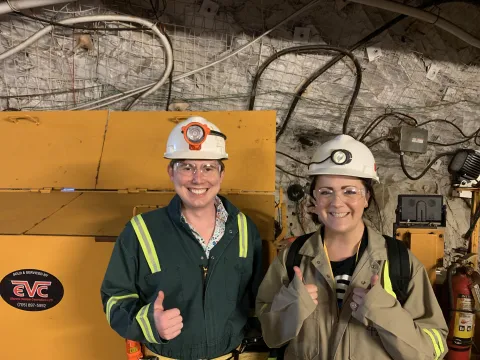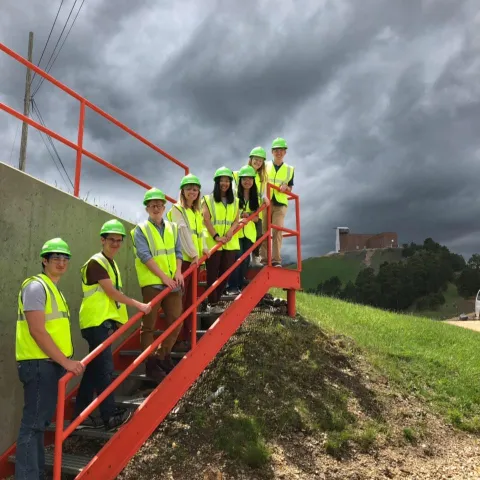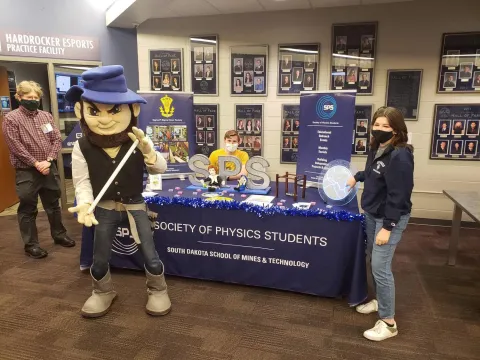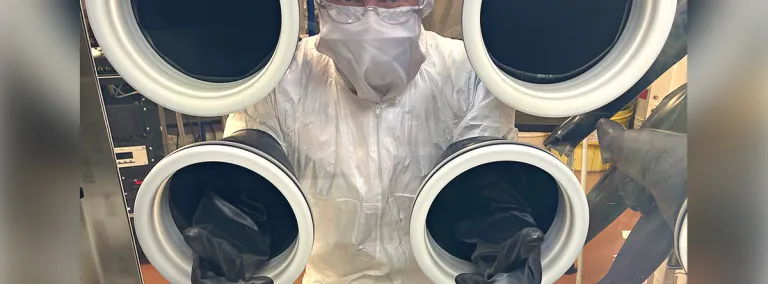Mines student finds there’s more than one way to become a physicist
For Schleich, the road to physics includes reading a children’s book, checking phone reminders, and finding a lab near you
For Sam Schleich, the door to physics cracked open when he picked up a children’s book at Barnes & Noble.
“The book did a great job of breaking down really big concepts into something a 10-year-old could understand,” Schleich said. “I was amazed. I spent months scouring Wikipedia articles about physics concepts. I didn’t understand most of it, as a young kid, but I found it all so interesting.”
From then on, Schleich knew he wanted to be a physicist. What he didn’t know was exactly how to become one.
“I used to stress about figuring out the exact steps I needed to take,” Schleich said. “I thought I’d have to do this, then this, then this, and then I’ll be a scientist.”
Alison Bowers, Schleich’s science teacher at Hanson High School in Alexandria, South Dakota, noticed his passion for physics right away. “I try to provide opportunities for students to follow their interests,” Bowers said. “Sam had clearly been learning a lot of science on his own, and I wanted to connect him to resources that could get him one step further into that field.”

When Schleich was a high school freshman, Bowers discovered a summer program through the Sanford Underground Research Facility (SURF) that demystified the process of becoming a scientist. The program was for high school seniors and college freshman, so they set a reminder.
Three years later, Schleich’s phone lit up with a notification: “Apply for Davis-Bahcall Scholars Program.”
Demystifying science
In 2019, Schleich and seven other Davis-Bahcall Scholars were connected with peers and mentors as they explored the modern world of science, technology, engineering, and mathematics (STEM) research.

The scholars spent three weeks exploring leading national and international laboratories and universities across the Midwest, including Fermi National Accelerator Laboratory and Argonne National Laboratory in Chicago, Illinois. Their final week was in Italy, where they visited Gran Sasso National Laboratory.
“We met so many researchers with different backgrounds and different paths into their careers,” Schleich said. “It made me realize that there’s no checklist, no specific path you have to take to become a scientist. It’s about leaning into what you enjoy and find interesting.”
Diving deep into science at SURF
When Schleich began studying physics at South Dakota Mines, he stayed connected to research at SURF.
In 2020, he took part in the Research Experiences for Undergraduates (REU) program, which typically gives students hands-on experience in lab environments. Due to COVID-19, however, students participated solely in online research, coding, and data analysis.
“I was excited to do hands-on research, but my involvement moved online,” Schleich said. “I'm really grateful, though, that they put in the effort to move it online, rather than fully canceling the program.”
Schleich spent his summer developing a coding simulation to flag false signals in the LUX-ZEPLIN dark matter detector at SURF. He said the program taught him how big science really works: “There's definitely a lot more behind the scenes than I originally thought. It's not just five scientists sitting in a room, coming up with all these ideas. There's a lot of undergraduate and graduate students helping with the smaller details, kind of like I did.”
Schleich’s hands-on experience came later, as an undergraduate research assistant with the Majorana Demonstrator collaboration. In early 2022, the Majorana Demonstrator was being converted for a new study, Schleich worked in the glovebox, carefully inserting tantalum plates inside the detector modules. He also helps the collaboration electroform the world’s purest copper for LEGEND-1000, their next generation experiment. In October 2022, Schleich had the opportunity to represent the collaboration, giving a talk about tantalum research in the Majorana Demonstrator at the American Physical Society’s Division of Nuclear Physics conference.
Last summer, Schleich attended the Majorana Demonstrator collaboration meeting in Minneapolis, Minnesota, where dozens of researchers shared advice on graduate and PhD programs in physics. Schleich, who will graduate from Mines next spring, welcomed the advice.
“With the connections and the experiences I’ve had as an undergrad, I feel better prepared for the future,” Schleich said. “I still don’t know exactly what that will be, which is scary and fun at the same time, because it leaves the door open for new possibilities.”
Creating strong futures in physics
Before he graduates, Schleich is building community and creating outreach opportunities for the next cohort of physics students at Mines.
Schleich is the president of the Mines chapter of the Society of Physics Students. The group indulges in the fun side of physics, building demonstrations like cosmic ray detectors, Rubens tubes, and theremins for outreach events. Each fall, the group builds trebuchets to launch pumpkins at Rapid City’s downtown “Pumpkin Chunkin” event.

Schleich is also a peer mentor, helping incoming freshman navigate courses and campus life.
“Sam’s been a great example to the newer, younger students,” said Michael Dowding, physics lecturer at Mines. “He shows students that you don’t have to be 100% serious all the time—you can have fun and really enjoy physics, too.”
Schleich is the vice president of the Mines Student Association Senate and vice president of the Student Federation, a coalition of representatives from each South Dakota Board of Regents university.
“At the Student Federation, we’re trying to come up with an action plan for bettering mental health programs at universities,” Schleich said. “I’m trying to bring that back from the state level to our campus and make that one of our student senate’s main priorities.”
To Schleich, this campaign is essential to his future in physics, too. “Science as a field has a reputation for being somewhat cold and callous,” Schleich said. “But at the end of the day, I think like the human aspect of science should always be the number one priority, and I want to do what I can to help with that.”
